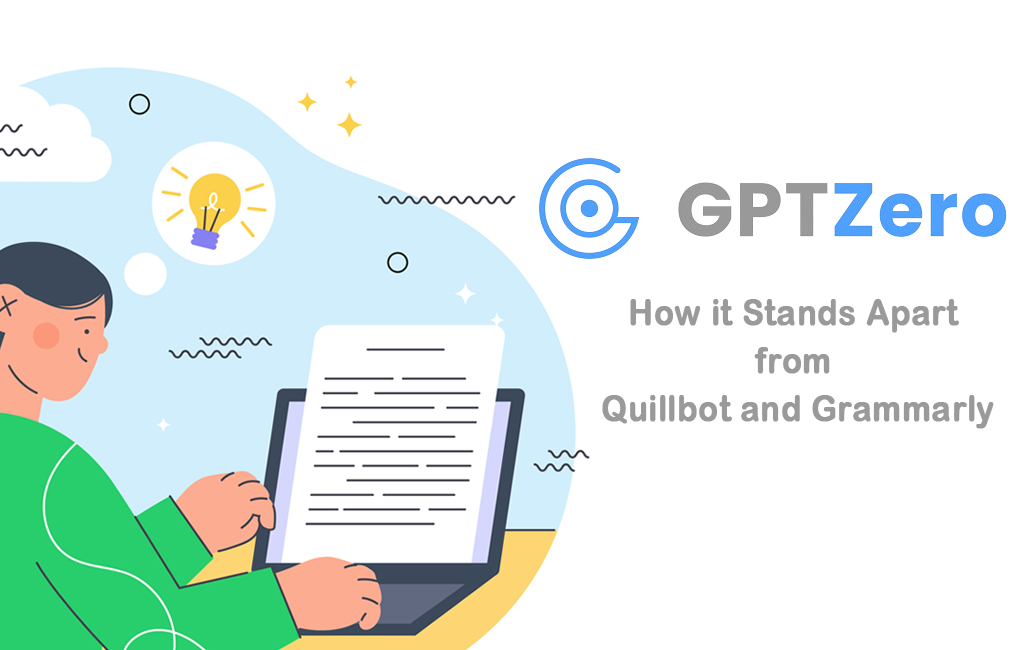The rapid advancement of generative AI models like ChatGPT has transformed content creation, enabling efficient text production but raising concerns about authenticity and originality. In this landscape, GPTZero, Quillbot, and Grammarly have emerged as essential tools, each addressing distinct writing needs. While Quillbot and Grammarly focus on enhancing writing quality through paraphrasing, grammar checking, and style improvements, GPTZero specializes in detecting AI-generated text.
This article provides a comprehensive exploration of GPTZero features, and recent advancements. It also compares GPTZero with Quillbot and Grammarly to highlight their distinct roles, ensuring a thorough understanding for users in education, publishing, and content creation.
Table of Contents
GPTZero Evolution
GPTZero was developed by Edward Tian, a Princeton University student majoring in computer science and minoring in journalism, as a response to concerns about AI-generated content in academic plagiarism. Launched on January 2, 2023, it attracted over 30,000 users in its first week, causing a temporary crash resolved with support from Streamlit. By May 2023, GPTZero raised $3.5 million in seed funding, followed by $10 million in a Series A round in July 2024, led by Footwork’s Nikhil Basu Trivedi, reflecting strong industry support. By August 2025, it serves over 10 million users globally and works with over 100 organizations, including the American Federation of Teachers and universities like the University of Virginia and Penn State. Its mission, rooted in Tian’s concerns about AI’s impact on data journalism, is to demystify AI in the classroom and promote responsible AI adoption across sectors.
How GPTZero Works
Unlike many competitors that rely on open-source models, GPTZero is fine-tuned for student writing and academic prose, achieving higher accuracy. Its mission-driven focus on responsible AI adoption sets it apart from providers offering detection as a secondary feature. GPTZero uses advanced NLP techniques to analyze text and determine whether it was written by a human or generated by AI models. Its detection methodology relies on two key metrics:
- Perplexity: Measures the randomness of word choice and sentence construction. AI-generated text typically has lower perplexity due to predictable patterns, while human writing is more varied and “surprising.”
- Burstiness: Assesses the variation in perplexity across sentences. Human writing shows greater variability, while AI-generated text is more uniform.
These metrics are analyzed at the sentence, paragraph, and document levels, providing a multi-layered approach to detection. GPTZero’s model, trained on a large, diverse corpus of human-written and AI-generated text with a focus on English prose, achieves high accuracy, with recent benchmarks reporting 98%+ accuracy for detecting content from advanced models like ChatGPT, GPT-4, GPT-3, GPT-2, LLaMA, Claude, Gemini, and services based on these models.
Users can paste text or upload a file (e.g., .txt, .docx, .pdf) into the GPTZero website or dashboard, or use the Origin Chrome Extension for one-click web page scanning. The tool returns an overall detection score and sentence-by-sentence highlighting of AI-generated sections.
Recent updates, have enhanced its performance against sophisticated AI models and improved handling of mixed-genre and multilingual content.
Features of GPTZero
GPTZero offers a robust set of features tailored for detecting AI-generated text, making it a versatile tool for educators, publishers, and professionals including:
- Sentence-by-Sentence Detection: Provides granular analysis, highlighting AI-generated sentences with descriptive results, aiding educators in providing targeted feedback.
- Chrome Extension (Origin): Enables one-click scanning of web pages, integrating with Google Classroom and Google Docs for real-time authenticity checks.
- Integrations: Compatible with educational platforms like Google Classroom, Canvas, Moodle, and Zapier, facilitating institutional adoption.
- Dashboard: Supports analysis of larger texts and batch files, ideal for institutions handling multiple submissions (GPTZero Dashboard).
- Writing Reports: Offers insights into the writing process, such as editing patterns and time spent, to support holistic feedback in education.
- Source Finder: Introduced in 2025, this tool identifies potential text sources, enhancing originality verification in publishing and news contexts.
- Authorship Tracking: Launched in September 2024, it compiles data on the writing process (e.g., copy/paste history, editing time), providing nuanced insights into content creation.
- Multilingual Support: Enhanced in May 2025 to accurately detect AI-generated text in languages like German, Portuguese, French, Spanish, and Hindi, with a false positive rate of less than 1%.
- Advanced AI Model Detection: Updated to detect content from advanced reasoning models like ChatGPT o1 and o1-mini, ensuring effectiveness against cutting-edge AI.
- Hallucination Detection and AI Source Identification: Planned features to detect AI-generated inaccuracies and identify specific AI sources, enhancing misinformation detection.
- GPTZero Docs: A developing platform to record and cite AI usage, promoting transparency in content creation.
These features make GPTZero the best AI Detection tool for ensuring content authenticity across diverse applications, from academic integrity to publishing standards.
Use Cases of GPTZero
GPTZero is designed for scenarios where content authenticity is critical, with applications across multiple sectors:
- Education: Ensures academic integrity by detecting AI-generated essays and assignments. It is used by thousands of educators and institutions, encouraging dialogue about AI use rather than immediate penalties. Teachers can use strategies like requiring primary source citations, in-class assignments, or peer discussions to complement GPTZero’s detection,.
- Hiring and Recruitment: Verifies the authenticity of application materials like cover letters and resumes, with adoption reported by 2024.
- Publishing: Checks for AI-generated content in manuscripts and articles, ensuring editorial standards for outlets like eprnews.
- Disinformation Detection: Identifies AI-generated misinformation on social platforms and news sites, aligning with community-driven fact-checking models.
Comparison with Quillbot and Grammarly
While GPTZero, Quillbot, and Grammarly leverage AI and NLP, their purposes and functionalities differ significantly, as outlined below:
| Aspect | GPTZero | Quillbot | Grammarly |
|---|---|---|---|
| Primary Purpose | Detect AI-generated text | Enhance writing (paraphrasing, grammar, summarizing) | Improve grammar, style, and clarity |
| Key Features | AI detection, sentence-level analysis, authorship tracking, source finder, multilingual support | Paraphrasing, grammar check, summarizer, AI detector (secondary) | Grammar check, style suggestions, plagiarism detection, generative AI (GrammarlyGO) |
| Target Audience | Educators, content creators, organizations concerned with AI-generated content | Students, professionals, content creators | Students, professionals, businesses |
| Technology | AI, machine learning, NLP (perplexity, burstiness) | AI, NLP | AI, machine learning, NLP |
| Focus on AI Detection | Specialized, with advanced metrics and 98%+ accuracy | Includes AI detector, but not primary focus | Includes authorship tracking, but primarily for writing enhancement |
| Accessibility | Free plan (10,000 words/month), premium plans with student discounts | Free and premium plans | Free and premium plans |
Key Differences
- Focus and Functionality: GPTZero specializes in detecting AI-generated text using perplexity and burstiness metrics, providing detailed authenticity reports at multiple levels. Quillbot focuses on paraphrasing, grammar checking, and summarizing, with a secondary AI detection feature that is less robust. Grammarly emphasizes grammar, spelling, style, and tone improvements, with generative AI tools like GrammarlyGO and authorship tracking, but its primary goal is writing enhancement, not AI detection.
- Use Cases: GPTZero is tailored for verifying authenticity in academic, publishing, and professional contexts, making it ideal for educators, content moderators, and hiring managers. Quillbot supports students and writers in rephrasing text to avoid plagiarism, while Grammarly caters to professionals and businesses seeking polished communication.
- Specialization: GPTZero’s focus on AI detection complements the broader writing enhancement capabilities of Quillbot and Grammarly, creating a synergistic workflow for content creation and verification.
Accuracy and Reliability
Independent benchmarking by TechCrunch and internal 2025 benchmarks confirm GPTZero’s 98%+ accuracy, particularly for student writing and academic prose, outperforming competitors. However, it may produce false positives, where human-written text resembling AI patterns is flagged. If human-written work is flagged, users can use GPTZero’s authorship tracking to provide evidence of their writing process (e.g., edit history) or discuss results with educators or editors to clarify authenticity. A study cited by Futurism estimated a potential 20% error rate for false positives in academic settings, highlighting risks of wrongful accusations. GPTZero acknowledges these limitations, recommending that results be used to start conversations rather than as definitive evidence, especially in education.
A 2023 study on medical texts reported GPTZero’s accuracy at 80%, with a low false-positive rate (10%) but a higher false-negative rate (35%), indicating challenges with complex or mixed content. Recent updates have reduced the false positive rate to less than 1% for supported languages, and improvements in detecting AI bypassing tools (e.g., Undetectable AI) enhance reliability.
Latest Updates (2025)
As of August 2025, GPTZero has introduced significant updates to enhance its capabilities:
- Source Finder: Identifies potential text sources, supporting fact-checking in publishing and news.
- Enhanced Detection for AI Bypassing Tools: Improved detection of content manipulated by tools like Undetectable AI, addressing evasion attempts.
- Multilingual Support Improvements: Model 3.2m supports accurate detection in German, Portuguese, French, Spanish, and Hindi, with a false positive rate of less than 1%.
- Advanced AI Model Detection: Detects content from reasoning models like ChatGPT o1 and o1-mini with 98%+ accuracy.
- Integration with Google Classroom and Google Docs: Enhances educator workflows for real-time feedback.
- Hallucination Detection and AI Source Identification: Planned features to detect AI-generated inaccuracies and identify specific AI sources.
- GPTZero Docs: A platform to record and cite AI usage, promoting transparency.
Future Roadmap
GPTZero plans to expand language support, improve detection of paraphrased or humanized AI text, and enhance real-time collaboration tools. These developments aim to address the evolving complexity of AI-generated content and further reduce false positives, ensuring reliability across diverse use cases.
Conclusion
GPTZero is a pivotal tool in the AI landscape, addressing the critical need to detect AI-generated text and ensure content authenticity. Its advanced detection methodologies, user-friendly features, and recent updates, such as multilingual support and Source Finder, make it indispensable for educators, publishers, and professionals. Unlike Quillbot and Grammarly, which excel in enhancing writing quality, GPTZero’s specialized focus on AI detection complements their functionalities, creating a comprehensive ecosystem for content creation and verification.







